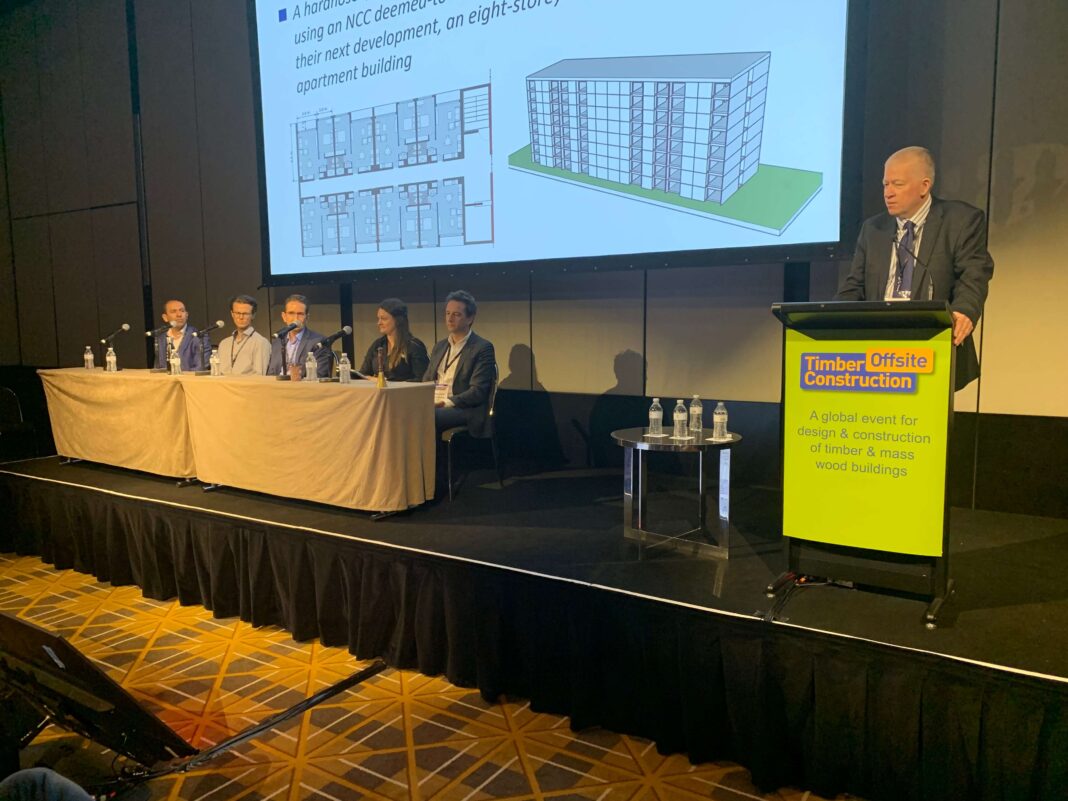The president of oWoW, the developer behind the USA’s first post and plate high-rise development, was among the headline speakers on the final day of the Timber Offsite Construction Conference.
Andrew Ball was one of 30 speakers who presented at the conference built around the theme ‘Timber & Technology: The Zero Carbon Future’.
He spoke during the ‘Global Developments & Trends’ discussion, chaired by Professor Perry Forsythe from the University of Technology, Sydney.
Featuring Steven Craft, Principal of CHM First Consultants in Canada and Eric Guenther, Principal of US-based Interstice Construction, the session featured three leading North American figures in mass timber construction.
Mr Ball, who travelled from the US to attend the conference, was impressed with the interest in mass timber construction across the region.
“You have earned the ‘wow’ factor,” he said.
He commented during a discussion on the trend towards point-supported mass timber buildings.
oWOW has an in-house development, design, construction, and property management team with a vision for a sustainable building product that is repeatable, highly sustainable, and provides affordable luxury housing to the middle income.
And they have grand aspirations, with Wood Central reporting in May that the company is targeting 600 global projects in the pipeline.



Using mass timber instead of concrete and steel, oWOW saved 15% overall cost and 25% for the construction team.
Their construction system of choice is a point support (post and flat plate) timber construction system that uses mass timber floor panels supported on columns only.
It was recently deployed in oWOW’s 18-storey mass timber building in Oakland, constructed over a one-level concrete podium.
Described as the world’s tallest beamless mass plywood structure, work on 1510 Webster Street was finalised after just eight months on site.

With an eye to future sessions, Mr Ball was impressed with the Murdoch University Boola Katatjin project, one of the two iconic building case studies discussed during the afternoon session.
Last week, Boola Katajin – the Southern Hemisphere’s largest mass timber structure – was awarded the WA Engineering’ Project of the Year.’
Aurecon accepted the award with Pratik Shrestha joining Blake Alexander from Luons, Jess Naller from Multiplex and Tysan Infanti from Hess Timber in the second last conference session.

In June, the WA chapter of the Australian Institute of Architects Awards awarded the project with the state’s top design award, with the university now a frontrunner to secure the national award, announced next month.
The project achieved a 6 Star Green Star Design and As-Built rating, which, according to the Green Building Council of Australia, “demonstrates leadership in sustainability on an international scale.”
The 180-meter-long structure even secured a feature on ABC’s Landline.
The project used more than 2,143 tonnes of timber, with mass timber pieces of all different lengths manufactured offsite before being assembled like a giant Meccano set or puzzle.

In June, Wood Central reported that, by volume, the glue-laminated timber beams used in the Northern Plaza are the largest installed in Australia by volume – at 7,282 kilograms in length and extending 26 metres.
The Timber Offsite Construction conference will wrap up later today, with the final session focused on the future of cities.



Featuring Olivia Thim from Vaxjo Munipal, the session will focus on Växjö, recognised as Modern Wooded City.
Växjö is known as “The Greenest City in Europe” and is the definition of a timber town. In 2017, Växjö was awarded the European Green Leaf Award 2018 by the European Commission.
As part of a timber strategy established in the early 2010s, the Växjö Municipality committed that by 2020, 50% of new builds would be timber-based, and in 2015, set a Sustainable Agenda for 2030, which leans heavily on low carbon timbers.
In addition, a Climate Impact Declaration is mandatory for all new buildings.
This declaration specifies that, from 2022, buildings whose load-bearing walls have the lowest CO2 footprint (CO2 emissions) will be given preference over other construction projects.
And from 2025, the focus will be on buildings with the lowest CO2 footprint.
Wood Central will provide further coverage from the conference.






